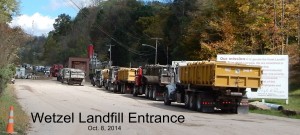“Landfill Drill Waste Unlikely to Get in Water”
From Shale Play, Wheeling Intelligencer, July 2, 2015
Charleston, WV (AP) – A study by state regulators says it’s unlikely that significant amounts of untreated natural gas drilling waste in landfills will impact groundwater or surface water.
In the event that the waste’s runoff did hit nearby water untreated, however, the material would likely exceed chemical limits for drinking water and be toxic to plants and invertebrate life, the study concludes.
In a report released Wednesday, the Department of Environmental Protection looked into the runoff from drill cuttings dumped into landfills. The report studied four of the six West Virginia landfills that accept drilling waste, and compared them to two others that don’t.
The report says most groundwater near the studied landfills isn’t used for public water supplies, but is likely used for some private water supplies.
Radioactive levels in landfills that accept the drilling waste sometimes exceeded state limits for radioactivity in waterways. Treatment facilities that took in the drilling material had radioactive discharges similar to ones that didn’t handle its treatment.
The study says a new landfill for the material could take five or more years to build and cost the oil and gas industry $80 million. At least two new landfills would be needed to ensure drill operators didn’t have to drive further to dump their material than they currently do, the report says.
The study outlined some risks of the material ending up in waterways untreated: heavy precipitation events, overflow of piping systems connecting landfills to treatment facilities, cracks in piping systems handling the fluids, treatment system failures and landfill liner failures.
“It cannot be determined if or when landfill leachate might impact groundwater in the long-term,” the report says. The report found that the drill cuttings were not suitable for road building, or capping of brownfield sites.
But it also says parts of the material could potentially be used in a mix to fill abandoned underground mines and keep them from collapsing, or to fill other unused structures, including underground storage tanks, sewers or abandoned basements.
Environmental officials collaborated on the report with the state Division of Highways, branches of Marshall University and Glenville State University, and Research Environmental & Industrial Consultants.
>>>>>>>>>>>>
Editorial RE: WV-DEP — Facts flow down hill
From an Editorial, Morgantown Dominion Post, Sunday, July 5, 2015
Landfill leachate from natural gas drilling waste may poison your water, but words never seem to hurt regulators. However, after reading the summary of a 200-page study released this past week on drill cuttings dumped into landfills, we have some words for the Department of Environmental Protection (WV-DEP).
Rarely do we engage in name calling, but this report leads us to believe WV-DEP actually stands for the Department of Environmental Prevarication. No, not in the sense the DEP is lying to us in this study, but it appears to deviate from the truth.
That doesn’t shock us. The idea of avoiding telling the truth by not directly answering a question is not some foreign concept to agencies. But this study does deflate some of our growing confidence in the safe operation of shale-gas drilling.
Only a month ago, an exhaustive, five-year, more than $30 million report by the US Environmental Protection Agency determined shale-gas drilling had caused no widespread harm to drinking water. Then, just about a week ago, drilling got under way on a “science well” and two other (Marcellus gas wells) along the Monongahela River that are under a bevy of researchers’ microscopes, so to speak.
But now it appears after taking two steps forward, we’re about to take one back. To its credit, this report doesn’t give inferences or suppositions any credence. Rather, it hinges on probabilities and deductive reasoning. Yet, it fails to estimate these probabilities and the end-result of the reasoning holds out little comfort.
For instance, it asserts it’s unlikely these cuttings in landfills will affect groundwater or surface water. Also, most groundwater near the landfills it studied isn’t used for public water supplies. But then it reports if this runoff hit nearby water untreated, it would likely exceed chemical limits for drinking water and would be toxic to invertebrate life. That toxicity might not apply to humans, too, but it sounds risky, at best.
The report also noted groundwater near these landfills is likely used for private water supplies. The study also noted how the material could end up in waterways untreated: Heavy precipitation events. Downpours? Cracks in piping systems linking landfills to treatment facilities ranked high. Treatment system and landfill liner failures were also outlined.
Then in a brilliant stroke the report concludes, “It cannot be determined if or when landfill leachate might impact groundwater in the long-term.”
Through the years, we suspect, the WV-DEP has often ignored its own findings or warnings, probably at the behest of industry or politics. However, it’s apparent many of this report’s words spell out a world of potential harm.
>>>>>>>>>>>>>
NOTE: See the report here: ”Final Report on the Examination of Drill Cuttings and Related Environmental, Economic, and Technical Aspects Associated with Solid Waste Facilities in West Virginia,” W. V. Department of Environmental Protection, July 1, 2015.
See also: www.FrackCheckWV.net

